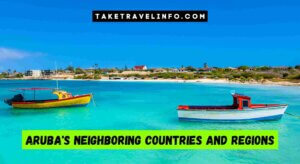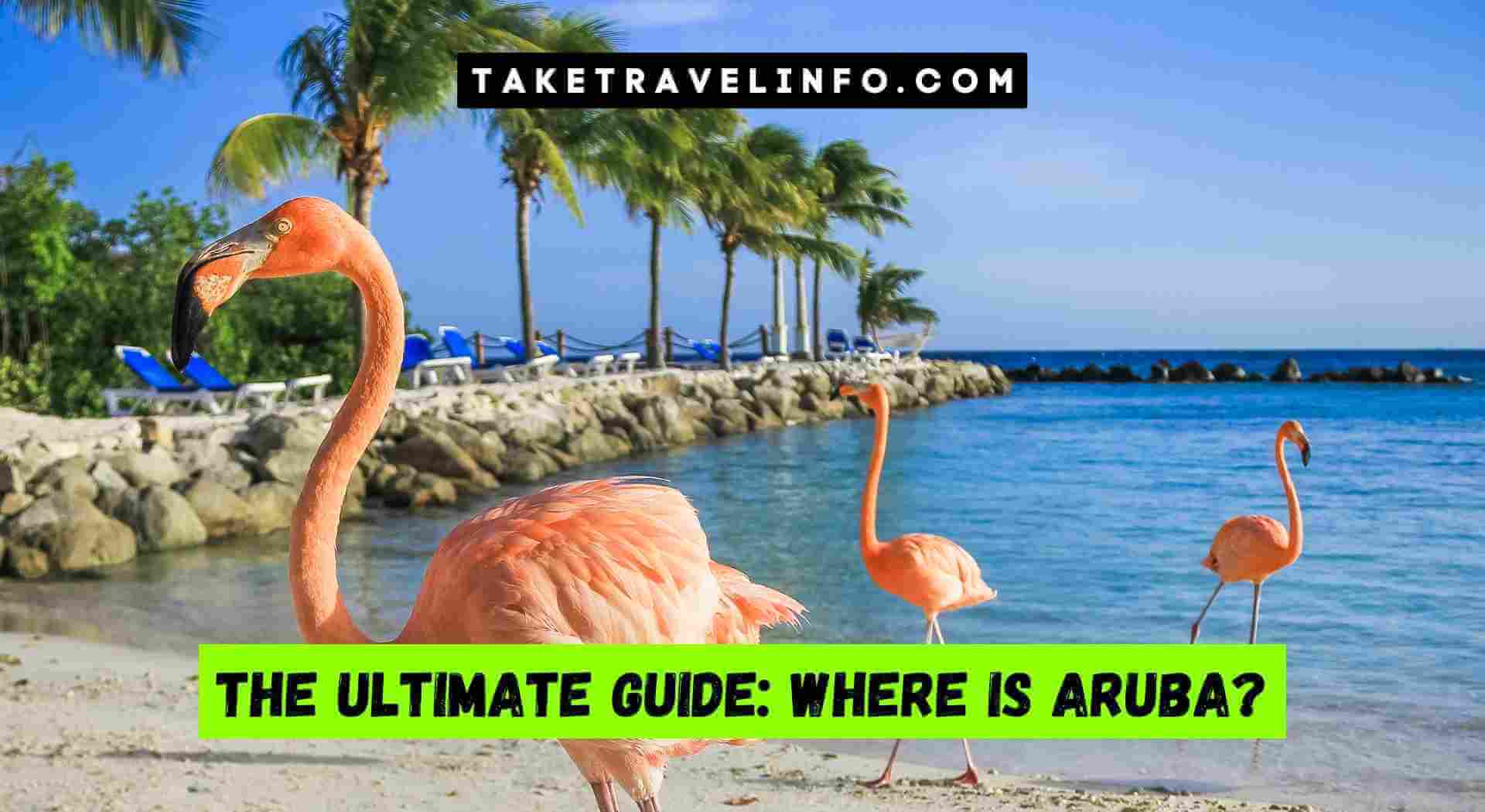Aruba is located in the Caribbean Sea, off the coast of Venezuela. Known for its beautiful beaches and turquoise waters, Aruba is a popular tourist destination in the southern Caribbean.
With a land area of approximately 70 square miles, the island is part of the Kingdom of the Netherlands. It is situated outside of the hurricane belt, which makes it an ideal vacation spot year-round. Aruba offers a diverse range of activities, including water sports, shopping, dining, and exploring its unique natural landscapes.
Whether you’re looking for relaxation or adventure, Aruba has something for everyone seeking a tropical getaway.
An Introduction To Aruba’s Location

Aruba’s Geographical Location And Significance As A Caribbean Island
Aruba is a tropical paradise located in the southern Caribbean Sea. Known for its pristine beaches, crystal-clear waters, and year-round warm weather, this small island holds a significant place in the Caribbean region. Here are some key points about Aruba’s geographical location and its significance as a Caribbean island:
- Situated just off the coast of Venezuela, Aruba is one of the lesser Antilles islands, which form an arc-shaped group in the Caribbean Sea.
- Aruba lies approximately 18 miles (29 kilometers) north of mainland Venezuela, making it one of the closest Caribbean islands to South America.
- Being outside the main hurricane belt, Aruba enjoys a relatively low risk of encountering severe tropical storms or hurricanes. This factor has contributed to its popularity as a vacation destination throughout the year.
- With an area spanning around 70 square miles (180 square kilometers), Aruba is a relatively small island. However, its compact size allows visitors to explore various attractions, from lively resorts to tranquil desert-like landscapes.
Understanding Aruba’S Location Within The Lesser Antilles Island Group
Aruba’s positioning within the lesser antilles island group provides it with unique characteristics. Here’s an overview of its location within this island chain:
- The lesser Antilles islands extend in a long arc from the southeast of puerto rico to the coast of Venezuela. This region is divided into two main groups: The leeward islands and the windward islands.
- Aruba belongs to the leeward islands, which are located in the western part of the lesser Antilles. These islands are known for their calm waters and picturesque landscapes.
- The leeward islands include popular Caribbean destinations such as Antigua and Barbuda, st. Kitts and Nevis, and St. maarten. Aruba stands out as one of the most sought-after locations due to its unique blend of Dutch influence, vibrant culture, and stunning natural beauty.
The Unique Positioning Of Aruba About Neighboring Islands
Aruba’s strategic location showcases its distinctiveness and proximity to neighboring islands. Here’s what sets Aruba apart in terms of its geographical positioning:
- Positioned west of the windward islands like Grenada and Barbados, Aruba is a unique outlier within the eastern Caribbean.
- While other Caribbean islands are known for their lush rainforests and towering mountains, Aruba boasts a contrasting landscape of arid deserts and cactus-filled terrains. This aridity gives Aruba its characteristic dry climate and distinct ecosystem.
- Aruba’s location in the southern Caribbean also contributes to its diverse marine life. The nutrient-rich waters surrounding the island support vibrant coral reefs, making it a haven for snorkelers and scuba divers.
Aruba’s geographical location within the lesser Antilles island group and its juxtaposition with neighboring islands make it a truly exceptional Caribbean destination. Its proximity to South America, low hurricane risk, and distinctive landscape make it an ideal vacation spot for travelers seeking sun, sand, and a unique island experience.
The Geographical Features Of Aruba

Exploring The Physical Characteristics Of Aruba
Aruba, known as “one happy island,” is a mesmerizing Caribbean destination famed for its stunning geographical features. From its size and topography to its diverse coastline, Aruba offers a unique blend of natural wonders that captivate the hearts of both locals and tourists.
The Size And Topography Of The Island
- Aruba is a relatively small island, spanning approximately 20 miles long and 6 miles wide.
- Despite its compact size, Aruba stands out with its diverse topography, encompassing rocky coastlines, lush landscapes, and even desert-like terrains.
- The island’s highest point, mount Jamanota, stands at 617 feet and provides visitors with breathtaking panoramic views.
Aruba’s Diverse Coastline And Its Impact On Tourism
- Aruba boasts a diverse coastline that stretches over 70 miles, featuring an array of stunning beaches and hidden coves.
- Palm Beach, eagle beach, and baby beach are just a few examples of the island’s world-renowned shorelines, each offering its unique charm and atmosphere.
- The pristine white sands, crystal-clear turquoise waters, and vibrant marine life make Aruba’s beaches a paradise for sun-seekers, snorkelers, and divers alike.
- The coastline’s appeal goes beyond its natural beauty, as it plays a crucial role in making Aruba a thriving tourist destination.
- Aruba’s tourism industry thrives on the variety of watersports and recreational activities that the diverse coastline offers, including windsurfing, paddleboarding, and sailing.
- The beaches also serve as the backdrop for luxurious resorts, trendy beach bars, and lively beach parties, attracting visitors from around the world.
Aruba’s geographical features make it a captivating destination. Its size and topography offer a unique blend of landscapes, while the diverse coastline provides a haven for beach lovers and water enthusiasts. Whether you seek relaxation, adventure, or simply a slice of paradise, Aruba has it all.
So pack your bags and embark on an unforgettable journey to this idyllic Caribbean gem.
Aruba’s Neighboring Countries And Regions

Aruba, a Caribbean island, is a popular vacation destination known for its stunning beaches, rich culture, and vibrant nightlife. But where exactly is Aruba located? In this section, we will explore Araba’s neighboring countries and regions to give you a better understanding of its location and proximity.
The Proximity Of Aruba To South America
Aruba is conveniently situated in the southern Caribbean Sea, approximately 15 miles off the coast of Venezuela. Its strategic location puts it near the south american continent, making it easily accessible for travelers from both North and South America.
The Countries And Regions That Border Aruba
Aruba shares its maritime borders with two neighboring countries and is part of a wider region known as the ABC islands.
Venezuela
To the south of Aruba lies the vibrant country of Venezuela. With just a short distance separating the two, Aruba benefits from strong cultural and historical ties to its south american neighbor. Many visitors to Aruba also take the opportunity to explore Venezuela and experience its unique attractions, such as the stunning angel falls and the vibrant city of Caracas.
The Abc Islands: Bonaire And Curaçao
In addition to its connection with Venezuela, Aruba shares a close bond with its sister islands, Bonaire, and Curaçao. Collectively referred to as the ABC islands, these three dutch caribbean territories offer diverse landscapes, rich biodiversity, and vibrant Caribbean cultures.
Bonaire, known for its exceptional scuba diving and snorkeling opportunities, is located east of Aruba. Its protected marine park attracts water enthusiasts from around the globe.
Curaçao, located to the west of Aruba, is renowned for its colorful architecture, pristine beaches, and vibrant capital city, Willemstad. Visitors to Aruba often take the opportunity to explore the unique charm and cultural heritage of Curaçao.
The Caribbean Sea
Aruba is surrounded by the azure waters of the Caribbean Sea, offering visitors breathtaking views and endless opportunities for water activities. From snorkeling and diving to sailing and fishing, the Caribbean Sea plays a significant role in shaping Aruba’s appeal as a tropical paradise.
Aruba’s location in the southern Caribbean Sea provides easy access to nearby south american countries such as Venezuela, as well as the neighboring islands of Bonaire and Curaçao. Its strategic positioning in the Caribbean Sea contributes to its allure as a premier vacation destination for travelers seeking a perfect blend of stunning beaches, vibrant culture, and natural beauty.
So, pack your bags and get ready to embark on an unforgettable adventure in this Caribbean gem!
Aruba’s Climate And Weather Patterns

Aruba is a small island located in the southern Caribbean Sea, just off the coast of Venezuela. This tropical paradise boasts a unique climate and weather patterns that attract many visitors throughout the year. In this section, we will explore Aruba’s tropical climate, the impact of the Caribbean Sea on its weather, and the best time to visit based on weather conditions.
Exploring Aruba’S Tropical Climate
Aruba enjoys a tropical climate characterized by warm temperatures and refreshing trade winds. Here are the key points about Aruba’s climate:
- Average temperatures range from 75°f (24°c) to 85°f (29°c) year-round, offering a pleasant environment for beach activities and outdoor exploration.
- The island experiences a relatively low annual rainfall of around 20 inches, making it a popular destination for sun-seekers.
- Aruba is located outside the hurricane belt, which means it is rarely affected by these destructive storms. Visitors can enjoy a worry-free vacation without the threat of hurricanes.
The Impact Of The Caribbean Sea On Aruba’S Weather
The Caribbean Sea plays a significant role in shaping Aruba’s weather patterns. Here’s what you need to know:
- The sea moderates Aruba’s climate, providing a cooling effect during the day and warmth during the night. This makes the island’s temperature relatively stable throughout the year.
- The constant trade winds, influenced by the sea, help keep Araba’s coastal areas comfortable, especially during the hottest months.
- The northeast trade winds also contribute to making Aruba a popular destination for windsurfing and other water sports. Adventurers flock to the island to take advantage of these consistent winds.
The Best Time To Visit Aruba Based On Weather Conditions
The weather in Aruba remains favorable for tourism all year round. However, certain months offer optimal conditions for specific activities. Consider these points when planning your visit:
- December to April is the peak tourist season in Aruba, as it offers the most pleasant weather with lower humidity levels, little rainfall, and warm temperatures. This period is perfect for beach lovers and outdoor enthusiasts.
- May to November is the low season due to slightly higher temperatures and increased chances of rainfall. Despite this, the weather is still enjoyable, and it’s an ideal time for budget travelers looking for deals on accommodations and flights.
- June to November marks the official hurricane season, but Aruba’s location outside the hurricane belt significantly reduces the risk of encountering severe weather.
Remember, Aruba’s weather is generally favorable year-round, so you can plan your visit based on your preferences and activities.
Now that we have explored Aruba’s tropical climate, the influence of the Caribbean Sea, and the best time to visit, you’re well-equipped to make the most of your trip to this stunning island destination. Enjoy the sun, sand, and remarkable experiences Aruba has to offer!
Aruba’s Culture And Language

The Unique Cultural Blend Of Aruba
Aruba, a stunning Caribbean island tucked away in the southern Caribbean Sea, is known for its vibrant culture and warm tropical vibes. With a rich history shaped by various influences, Aruba’s unique cultural blend is a true delight to explore.
From indigenous roots to Spanish, Dutch, and African influences, this tiny island has developed a distinct identity that captivates visitors from around the world.
Influences From Indigenous, Spanish, Dutch, And African Cultures
Aruba’s culture is a beautiful tapestry woven together by the contributions of various ethnic groups. Here are some key influences that have shaped the island’s vibrant cultural landscape:
- Indigenous heritage: The Arawak Indians were the first inhabitants of Aruba, and their presence is still felt today in various aspects of the island’s culture. Traditional crafts, such as pottery and basket weaving, reflect the indigenous legacy.
- Spanish influence: Aruba was colonized by the Spanish in the 16th century, leaving behind a lasting influence on the island’s architecture, cuisine, and religious practices. The Spanish legacy can be seen in charming colonial buildings and the annual carnival celebrations.
- Dutch connection: Since 1634, Aruba has been under Dutch influence, ultimately becoming a constituent country within the Kingdom of the Netherlands. Dutch architecture, legal systems, and administrative practices have significantly shaped the island’s development.
- African heritage: The impact of African culture is evident in Aruba’s music, dance, and culinary traditions. African influences are particularly prominent during festivals and carnivals, where vibrant rhythms and mesmerizing dance moves take center stage.
The Official Languages Of Aruba And Their Significance
Aruba is a multilingual destination with two official languages – dutch and Papiamento. Here’s a closer look at each language and its significance:
- Dutch: As a remnant of the island’s colonial history, dutch serves as one of Aruba’s official languages. It is primarily used in government affairs, education, and formal settings. While most Arubans can understand and speak Dutch, English is often more commonly used in interactions with tourists.
- Papiamento: Papiamento is a Creole language that originated in the Caribbean and is widely spoken in Aruba. It is a fascinating blend of Portuguese, Spanish, Dutch, and African languages, making it a unique linguistic treasure. Papiamento is the language of everyday conversation, and its vibrant use embodies the island’s rich cultural diversity.
The official languages of Aruba not only reflect its historical background but also serve as a testament to the cultural melting pot that is on the island. Embracing both Dutch and Papiamento is a testament to Aruba’s commitment to preserving its roots and creating a sense of unity among its people.
Aruba’s cultural tapestry, woven with influences from indigenous, Spanish, Dutch, and African cultures, is a testament to its fascinating history. The island’s official languages, dutch and Papiamento, further showcase its diverse heritage. Immerse yourself in Aruba’s warm and welcoming culture, where the spirit of the island comes alive in its vibrant traditions and lively celebrations.
Aruba: A Destination For Adventure And Relaxation

Aruba, a hidden gem in the Caribbean, is an island paradise that offers a perfect blend of adventure and relaxation. Whether you are seeking adrenaline-pumping activities or a tranquil escape, Aruba has something for everyone. Let’s explore the variety of activities and attractions in Aruba that make it a must-visit destination.
The Variety Of Activities And Attractions In Aruba:
- Aruba’s stunning beaches: With pristine white sands and turquoise waters, Aruba boasts some of the most beautiful beaches in the Caribbean. From the popular eagle beach to the picturesque bay beach, you can indulge in sunbathing, swimming, or even taking a leisurely walk along the shoreline.
- Water sports galore: Aruba is a haven for water sports enthusiasts, offering a wide range of activities such as snorkeling, diving, windsurfing, and paddleboarding. Explore the vibrant underwater world, witness vibrant coral reefs, and swim alongside tropical fish.
- Arikok national park: Embark on an adventure through Arikok national park to discover Aruba’s natural wonders. Explore the rugged terrain, hike through diverse landscapes, and marvel at hidden caves and natural pools. Don’t forget to catch a glimpse of the iconic natural bridge, a stunning limestone formation.
Exploring Aruba’S Natural Wonders:
- The natural pool: Also known as a conch, the natural pool is a secluded oasis surrounded by a rugged coastline. Take a dip in its crystal-clear waters, go cliff jumping, or simply relax while embracing the breathtaking views.
- Alto Vista Chapel: Perched on a hilltop, this historic chapel is a must-visit. Enjoy a serene atmosphere and panoramic vistas as you admire the charming architecture and delve into the island’s rich cultural heritage.
- California Lighthouse: Climb the steps of the iconic California lighthouse for a panoramic view of the island. Capture stunning photographs as the sun sets over the Caribbean Sea, creating a magical experience.
- Flamingo Beach: Located on the private Renaissance island, this idyllic beach is home to a flock of friendly flamingos. Immerse yourself in the beauty of these graceful creatures, relax on the soft sands, and enjoy the pristine waters.
Balancing Adventure And Relaxation During A Trip To Aruba:
- Pampering spas: Indulge in luxurious spa treatments and massages offered by many resorts on the island. Let the stress melt away as you unwind and rejuvenate in a tranquil oasis.
- Sunset cruises: Witness mesmerizing sunsets aboard a romantic sunset cruise. Sip on tropical cocktails, experience the gentle breeze, and take in the stunning hues of the sky as the sun dips below the horizon, creating a captivating spectacle.
- Shopping and dining: Aruba is home to lively shopping districts and a vibrant dining scene. Explore the colorful boutiques, purchase unique souvenirs, and savor delicious local cuisine, including fresh seafood and authentic Caribbean dishes.
Aruba’s enticing mix of adventure and relaxation is what sets it apart from other destinations. Whether you seek thrilling activities, serene natural wonders, or simply a place to unwind, Aruba offers the perfect balance. Embark on an unforgettable journey in Aruba and create memories that will last a lifetime.
Frequently Asked Questions For Where Is Aruba?
What Is The Location Of Aruba?
Aruba is a beautiful island located in the southern Caribbean Sea, situated just off the coast of Venezuela.
Is Aruba A Safe Travel Destination?
Yes, Aruba is known for its safety and low crime rate. The island takes pride in providing a secure environment for tourists.
What Is Aruba Famous For?
Aruba is famous for its stunning white sandy beaches, crystal-clear turquoise waters, and vibrant marine life, making it a haven for beach lovers and water sports enthusiasts.
Conclusion
In this blog post, we have explored the question: where is Aruba? Located in the southern Caribbean Sea, Aruba is a stunning island known for its pristine beaches, crystal-clear waters, and vibrant culture. As a sought-after tourist destination, Aruba offers a variety of activities such as snorkeling, diving, and exploring its natural wonders like the arikok national park.
With its sunny weather all year round, Aruba is an ideal getaway for those seeking sun, relaxation, and adventure. Whether you are a beach lover, an adventure seeker, or someone interested in immersing yourself in local culture and cuisine, Aruba has something to offer everyone.
So, if you are planning your next vacation, consider Aruba as your destination and get ready to create unforgettable memories in this tropical paradise.


1 thought on “The Ultimate Guide: Where is Aruba?”